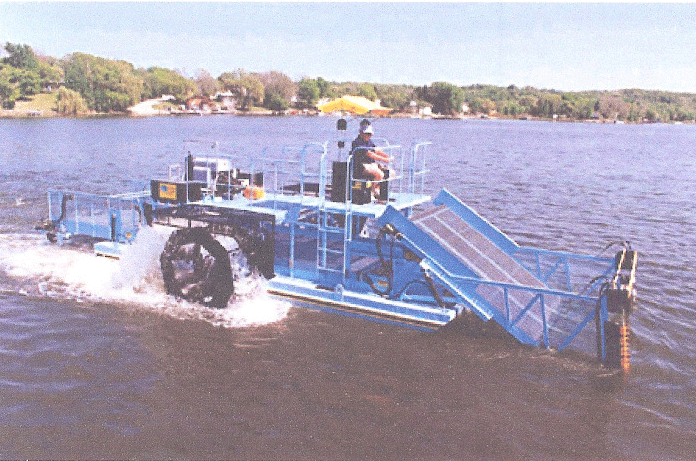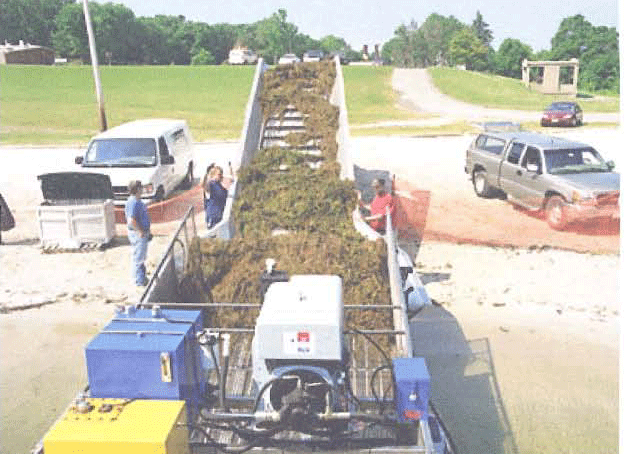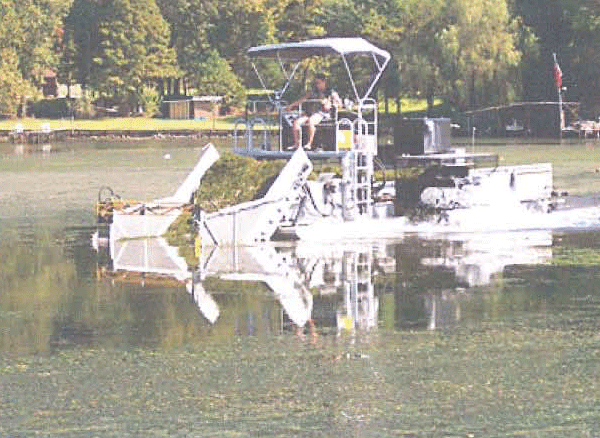Harvesting
:ilformation Last Reviewed May 2005
Description
Aquatic plant harvesters are floating machines that simultaneous1y cut and remove vegetation from the water. The cutter head uses sickles similar to those found on farm equipment, and generally cuts from one to six feet deep. A conveyor belt on the cutter heacUS.always in motion, bringing the clippings onboard the machine for storage. Once full, the harvester travels to shore to discharge the load of weeds
off the stern of the vessel.
Harvesters come in a variety of sizes, with cutting swaths ranging from four to twelve feet in width. The onboard storage capacity varies as well, and is measured in both volume and weight. Harvester storage capacities generally range from 100 to 1000 cubic feet of vegetation by volume, or from one to eight tons. They are usually propelled by two paddle wheels that provide excellent maneuverability and will not foul in dense plant growth. Harvesters may be propelled by twin hydraulically powered props.
In larger harvesting programs, or where there is a long distance to shore for unloading, a transport barge is often used. The transport barge acts as a weed shuttle for the harvester, taking the load of vegetation to shore and aHowing the harvester to return more quickly to work. Transports move faster and increase the efficiency of a harvesting operation by eliminating the travel time for the harvester. Most transports are propelled by twin hydraulically powered props.

The harvester and transport typically unload the vegetation into a shore conveyor or trailer-conveyor. The shore conveyor elevates the weeds up and into a waiting dump truck. The trailer-conveyor looks like a wagon when parked at the water's edge and receives and hauls the vegetation. Once the wagon-like sidewalls are removed, it functions as a regular trailer for the harvester.
The harvested vegetation is often taken to a local farm where it is eventually used as a soil conditioner. Sometimes it goes to the community compost site where it mixes well with grass clippings and leaves to form compost. In some parts of the country the weeds are taken to a landfill for disposal. The Wisconsin Department of Natural Resources reported that the nutrient value of the harvested weeds is comparable to cow manure. There are usually no seeds in the vegetation that will grow on land. However, some
harvesting area, the better the performance of the equipment.
Timing can also play an important role in the efficiency of harvesting operations. Some invasive aquatic plants grow rapidly toward the surface of the lake. Once reaching the surface, it continues to generate biomass in the upper few feet of the water column. If the first cut of a harvesting operation takes place later in the growing season, there will be considerably more biomass to collect, and the harvester will fill much faster. As the performance of the harvester is directly related to how much time it spends harvesting versus transporting, additional biomass can reduce production.
By the same token, attempting to harvest this weed too early in the season can hamper the effectiveness of the operation as well. If the plants are 3 to 5 feet below the lake surface, the harvester will be collecting just the top portion of the plant. The ideal time to harvest most submersed invasive weeds is just before the plants break the surface of the water.
When harvesting floating aquatic plants the timing of the harvesting operation is important. Managers should attempt to collect plants early in the growing season when their biomass is less. Another consideration is the direction of the prevailing wind. Floating plants can disperse in the habitat when pockets of open water occur. The removal of large areas of floating plant will require removal operations to occur over days or weeks and wind patterns can push vegetation back into areas already cleared. Managers should attempt to remove plants so that the open water areas created are not infested again by wind blown plants. Where practical the use of containment devices, like light weight floating oil booms, can be used to help corral the floating plants for more efficient collection.
Timing can also be an important factor when controlling certain types of plants. For example, managers try to aggressively cut curly leaf pond weed early in the year before it goes to seed, and before it naturally dies back as the water gets warmer. Other managers cut eurasian milfoil in late summer or early autumn before the plant has a chance to auto-fragment. And some managers in the northeast U.S. aggressively cut water chestnut each summer to prevent flowering and eventual seed formation.
Aquatic plant harvesting operations can be impaired if there are large concentrations of underwater obstacles in the vicinity of the invasive plant species that are targeted for control. Most harvesting systems have protection built into the harvesting head to absorb shock if an underwater obstruction is encountered. If there are large concentrations of these, for example in reservoir systems that have been impounded without a timber harvest and stump removal program, harvesting performance will be marginal.
Some invasive plant species are spread primarily by fragmentation once introduced into a lake system. While aquatic plant harvesters collect the bulk of the vegetation they cut, there are fragments that are not collected (such as those generated by the knives and the paddlewheels). If the manager is facing a pioneering infestation of this weed in a lake or river system, harvesting should be considered only as a last resort. Harvesting this weed under these conditions could actually accelerate the dispersal of the plant throughout the lake system by speeding up the fragmentation rate. Other mechanical options such as diver dredge, diver hand removal, or bottom barriers would be a better choice. Chemical or biological control options may also be appropriate.
If a manager has selected a contractor to perform harvesting operations, or in house equipment has been purchased for use on a number of different lakes, an equipment inspection program should be conducted to ensure that unintentional spread of an invasive plant species does not occur. Often contractors are moving from lake to lake. Before a machine comes into a lake, it should be inspected and any plant material present removed. This will help protect the lake from the introduction of other potential problem weeds. It also helps to know what lake the contractors have recently worked on, and what problem plants might be present there. Upon leaving the lake, it is also a good idea to require that the equipment be cleaned before moving to the next project. These precautions help stop the spread of invasive plant species to other lakes in the region. This is perhaps one of the most important steps a manager should consider: The protection of other water resources from this weed.

Expected Results
Most aquatic plant harvesting systems will cut and remove submersed plants to a depth of five or six feet. As this biomass is removed from the lake, the water is immediately ready for use and there are no restrictions on use of the area that might be experienced with herbicide or some biological control
treatments.
Removal of this biomass prevents its eventual decay and settling to the bottom, helping to reduce sedimentation in the lake. There is some nutrient removal with harvesting too, as the nitrogen and phosphorous that is bound up in the plant exits the water body. Harvesting is usually not lethal, leaving behind an oxygen and possibly habitat producing plant, which may be desirable in some situations.
Many harvester managers have witnessed a reduction in nuisance plant growth after a few years of repeated harvesting. The plants showed signs of stress and came back thinner, lower growing, and more scattered than before. In some cases desirable plants were able to out compete the nuisance plant growth.
Harvesting system performance is in the 2 to 8 acre per day range, depending on the equipment mix and the shoreline access available. A manager has to factor the amount of acreage to be cleared and the amount of time available for making the area weed free. If the water needs to be cleared more rapidly, other tools may be more appropriate.
This section was prepared by Jane Daffenbach of Aquarius-System.
varieties of plants are both aquatic and terrestrial, so care should be taken when disposing of them.
It is important that the cut vegetation be taken to a disposal site where fragments or decomposing weeds will not have contact with any body of water. This prevents nutrients from leaching back into the system, and disallows loose fragments from having an opportunity to revegetate or to be introduced to a new water body.
Aquatic plant harvesting systems are relatively slow compared to other control technologies. Depending on the density and type of vegetation, medium sized machines will harvest from two to six acres per day, and large machines will harvest from three to eight acres per day.
The equipment is often used in high-use/priority areas of lakes, to clear beaches and boat lanes, or to provide fishing areas within heavy weed infestations.
As a control technique, harvesting is a long term process requiring a commitment. It usually requires a capital investment, with the equipment having an average lifetime of 10 years. Most managers who run a harvesting program view the process as a maintenance function, much like plowing snow in the wintertime or mowing the lawn in the summer. They accept that the aquatic plants are a part of the system, and use harvesting as a way to balance human needs against nuisance or excessive plant growth.

The U.S. Army Corps of Engineers Aquatic Plant Control Research Program has developed a predictive model that is very useful in planning harvesting operations. This system allows the user to evaluate different mixes of equipment against the parameters that impact performance of harvesting systems and develop cost and time analyses. Copies of the model are found on the Aquatic Plant Information System (APIS). Copies of APIS can be obtained by contacting Michael Grodowitz (601/634-2972).
Operational Considerations
There are a number of operational considerations that should be taken into account when considering this management tool. For example, the efficiency of the harvesting operation is often determined by how far the harvester has to transport a load of cut vegetation. If a harvester can work close to a shore unloading site, it is possible to minimize the time that the craft spends transporting cut plants and maximize the time spent harvesting. The more offloading sites that the manager can locate in the